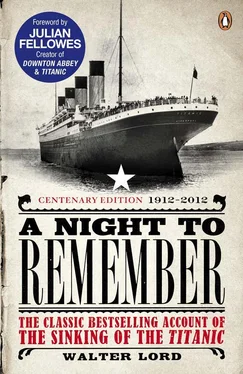Next to arrive was Bruce Ismay. He had pulled a suit over his pyjamas, put on his carpet slippers, and climbed to the bridge to find out whether anything was happening that the president of the line should know. Captain Smith broke the news about the iceberg. Ismay then asked, ‘Do you think the ship is seriously damaged?’ A pause, and the captain slowly answered, ‘I’m afraid she is.’
They would know soon enough. A call had been sent for Thomas Andrews, managing director of Harland & Wolff shipyard. As the Titanic ’s builder, Andrews was making the maiden voyage to iron out any kinks in the ship. If anybody could figure out the situation, here was the man.
He was indeed a remarkable figure. As builder, he of course knew every detail about the Titanic . But there was so much more to him than that. Nothing was too great or too small for his attention. He even seemed able to anticipate how the ship would react to any situation. He understood ships the way some men are supposed to understand horses.
And he understood equally well the people who run ships. They all came to Andrews with their problems. One night it might be First Officer Murdoch, worried because he had been superseded by Chief Officer Wilde. The next night it might be a couple of quarrelling stewardesses who looked to Andrews as a sort of supreme court. This very evening chief baker Charles Joughin had made him a special loaf of bread.
So far, Andrews’ trip had been what might be expected. All day long he roamed the ship, taking volumes of notes. At 6.45 every evening he dressed for dinner, dining usually with old Dr O’Loughlin, the ship’s surgeon, who also had a way with the stewardesses. And then back to his stateroom A-36, piled high with plans and charts and blueprints. There he would assemble his notes and work out his recommendations.
Tonight the problems were typical—trouble with the restaurant galley hot press… the colouring of the pebble dashing on the private promenade decks was too dark… too many screws on all the stateroom hat hooks. There was also the plan to change part of the writing room into two more staterooms. The writing room had originally been planned partly as a place where the ladies could retire after dinner. But this was the twentieth century, and the ladies just wouldn’t retire. Clearly, a smaller room would do.
Completely absorbed, Andrews scarcely noticed the jar and stirred from his blueprints only when he got Captain Smith’s message that he was needed on the bridge.
In a few minutes Andrews and the captain were making their own tour—down the crew’s stairway to attract less attention… along the labyrinth of corridors far below… by the water surging into the mail room… past the squash court, where the sea now lapped against the foul line on the backboard.
Threading their way back to the bridge, they passed through the A deck foyer, still thronged with passengers standing around. Everybody studied the two men’s faces for some sign of good news or bad; nobody could detect any clue.
Some of the crew weren’t so guarded. In D-60, when Mrs Henry Sleeper Harper asked Dr O’Loughlin to persuade her sick husband to stay in bed, the old doctor exclaimed, ‘They tell me the trunks are floating around in the hold; you may as well go on deck.’
In C-91 a young governess named Elizabeth Shutes sat with her charge, nineteen-year-old Margaret Graham. Seeing an officer pass the cabin door, Miss Shutes asked him if there was any danger. He cheerfully said no, but then she overheard him further down the hall say, ‘We can keep the water out for a while.’
Miss Shutes glanced at Margaret, who was uneasily nibbling at a chicken sandwich. Her hand shook so badly the chicken kept falling out of the bread.
No one was asking questions along the working alleyway on E deck. This broad corridor was the quickest way from one end of the ship to the other—the officers called it ‘Park Lane’, the crew ‘Scotland Road’. Now it was crowded with pushing, shoving people. Some were stokers forced out of boiler room No. 6, but most were steerage passengers, slowly working their way aft, carrying boxes, bags and even trunks.
These people didn’t need to be told there was trouble. To those berthed far below on the starboard side, the crash was no ‘faint grinding jar’. It was a ‘tremendous noise’ that sent them tumbling out of bed.
Mrs Celiney Yasbeck—a bride of fifty days—ran out into the corridor with her husband. Instead of making the long hike to the deck, it was easier to look below for trouble. In their night clothes they walked along to a door leading down to the boiler rooms and peeked through. Engineers were struggling to make repairs and get the pumps going. The Yasbecks needed no second glance—they rushed back to their cabin to dress.
Far above on A deck, second-class passenger Lawrence Beesley noticed a curious thing. As he started below to check his cabin, he felt certain the stairs ‘weren’t quite right’. They seemed level, and yet his feet didn’t fall where they should. Somehow they strayed forward off balance… as though the steps were tilted down towards the bow.
Major Peuchen noticed it too. As he stood with Mr Hays at the forward end of A deck, looking down at the steerage passengers playing soccer with the loose ice, he sensed a very slight tilt in the deck. ‘Why, she is listing!’ he cried to Hays. ‘She should not do that! The water is perfectly calm and the boat has stopped.’
‘Oh, I don’t know,’ Mr Hays replied placidly, ‘you cannot sink this boat.’
Others also felt the downward slant, but it seemed tactless to mention the matter. In boiler room No. 5, fireman Barrett decided to say nothing to the engineers working on the pumps. Far above in the A deck foyer, Colonel Gracie and Clinch Smith had the same reaction. On the bridge the commutator showed the Titanic slightly down at the head and listing five degrees to starboard.
Nearby, Andrews and Captain Smith did some fast figuring. Water in the fore-peak… No. 1 hold… No. 2 hold… mail room… boiler room No. 6… boiler room No. 5. Water fourteen feet above keel level in the first ten minutes, everywhere except boiler room No. 5. Put together, the facts showed a 300-foot gash, with the first five compartments hopelessly flooded.
What did this mean? Andrews quietly explained. The Titanic could float with any two of her sixteen watertight compartments flooded. She could float with any three of her first five compartments flooded. She could even float with all of her first four compartments gone. But no matter how they sliced it, she could not float with all of her first five compartments full.
The bulkhead between the fifth and sixth compartments went only as high as E deck. If the first five compartments were flooded, the bow would sink so low that water in the fifth compartment must overflow into the sixth. When this was full, it would overflow into the seventh, and so on. It was a mathematical certainty, pure and simple. There was no way out.
But it was still a shock. After all, the Titanic was considered unsinkable. And not just in the travel brochures. The highly technical magazine Shipbuilder described her compartment system in a special edition in 1911, pointing out, ‘The captain may, by simply moving an electric switch, instantly close the doors throughout and make the vessel practically unsinkable.’
Now all the switches were pulled, and Andrews said it made no difference.
It was hard to face, and especially hard for Captain Smith. Over fifty-nine years old, he was retiring after this trip. Might even have done it sooner, but he traditionally took the White Star ships on their maiden voyages. Only six years before, when he brought over the brand-new Adriatic , he remarked: ‘I cannot imagine any condition which would cause a ship to founder. I cannot conceive of any vital disaster happening to this vessel. Modern shipbuilding has gone beyond that.’ Now he stood on the bridge of a liner twice as big—twice as safe—and the builder told him it couldn’t float.
Читать дальше












